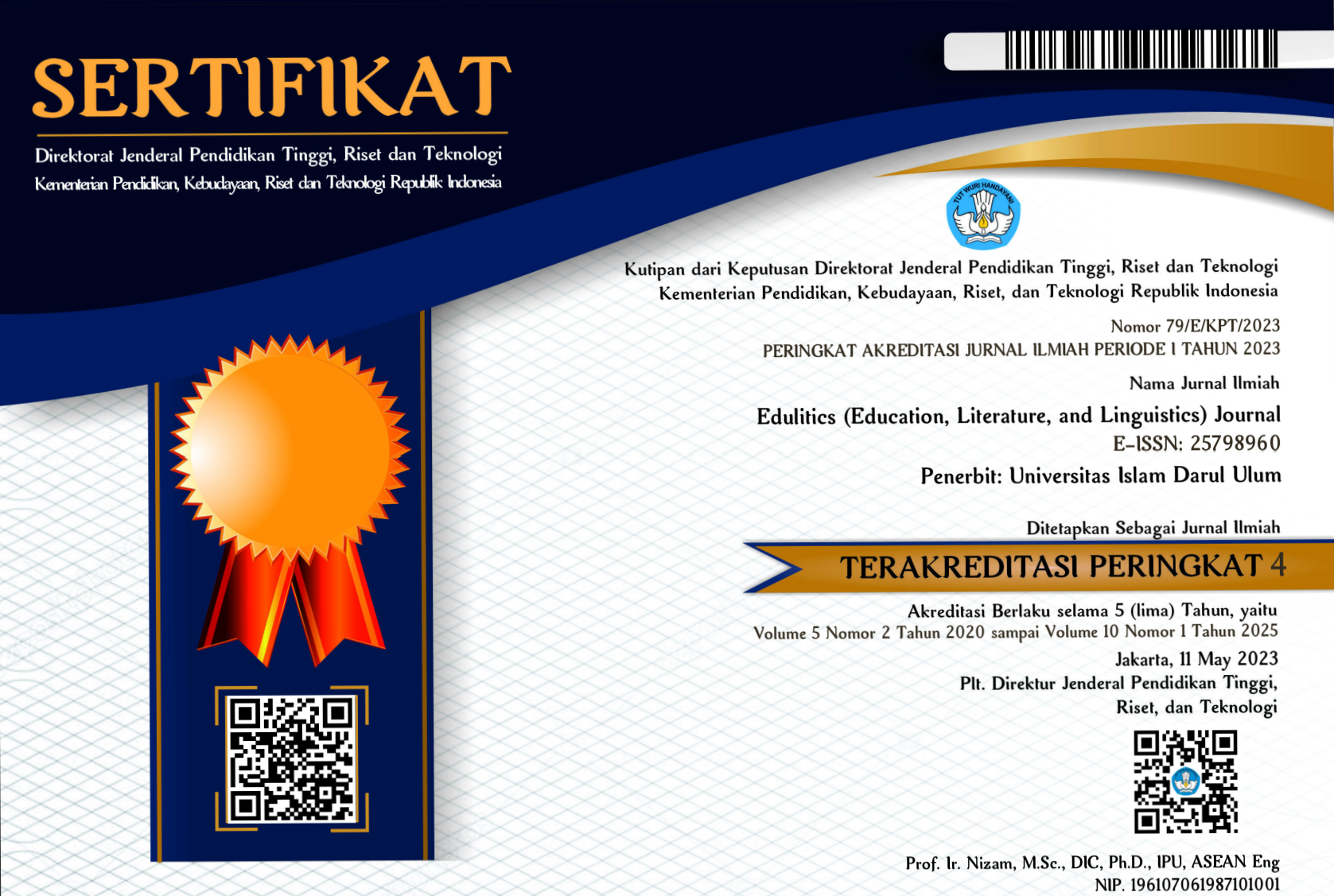Women's Simple Characters for the Downfall of the Mayor of Casterbridge in Thomas Hardy's the Mayor of Casterbridge
Abstract
There are a lot of studies about characters, most of which are about characters dealing with the good and bad characters as the result of the study. This study challenges the previous studies above that study on characters not merely deal with and bad but deal with survival through the characters. In Thomas Hardy’s the Mayor of Casterbridge, I study about women’s simple character for the downfall of the Mayor of Casterbriidge. Using New Criticism focusing on the characterization as well as close reading as a method, this study shows the result that the four women: Susan Henchard, Lucetta, Elizabeth Jane, and the furmity woman are above the greatness of the Mayor of Casterbridge through their simple character; Susan Henchard by her simple and natural act for the sake of her daughter future, Lucetta by her simple act to marry another man for fear of the terrible marriage with the Mayor of Casterbridge, Elizabeth Jane with her simple character to ignore the Mayor of Casterbridge for tricking her real father, and the furmity woman with her simple testimony of the terrible wife sale by the Mayor of Casterbridge. All women’s simple characters put the Mayor of Casterbridge in complete downfall in love and in business. In conclusion, though being a great man in the Casterbridge, Michael Henchard undergoes a complete downfall by the simplicity of the characters of the women. Finally, simple character is worth studying to prevent people to be arrogant.
Downloads
References
Bennett, A., & Royle, N. (2023). An introduction to literature, criticism and theory. Sixth Edition. Routledge.
Benziman, G., (2018). Thomas Hardy’s Elegiac Prose and Poetry codes of bereavement. Palgrave Macmillan
Berterns, H. (2014). Literary Theory the Basics. Routledge
Cuddon, J.A. (2013). A Dictionary of Literary Terms and Literary Theory. Viley-Blackwell
Dewi, N.K.K., Suwastini, N.K.A., & Jayantini, I.G.A.S.R. (2021). The Characterization of Amanda Collier In Nicholas
Sparks’ The Best Of Me (2011). International Journal of Language and Literature, 5(3), 123–136.
Eagleton, T. (2013). How to Read Literature. Yale University Press
Euron, P. (2019). Aesthetic, Theory and Interpretation of the Literary Work. BRILL SENSE
Ferguson, T. (2013). Thomas Hardy’s Legal Fiction. Edinburg University Press
Figlerowicz, M. (2016). Flat Protagonist, a Theory of Novel Character. Oxford University Press.
Habibah, I., Thoriqussuud, M., Rohman, A., Rohim, F., & Fanani, A. (2023). Quentin’s Personality Development in John Green’s Paper Towns. Interaction: Jurnal Pendidikan Bahasa, 10(2), 620-631.
Hardy, T. (1998). The Mayor of Casterbridge. Cambridge University Press.
Riris, K.L.M.N., Diana, P. B., & Suwastini, N. K. A. (2023). Snow White’s Characterization in Snow White and the Seven Dwarfs by Vera Southgate and Regis Maine: A Comparison from Liberal Feminists’ Perspectives. International Journal of Language and Literature, 7(1), 23–32. https://doi.org/10.23887/ijll.v7i1.60715
Nassaji, H. (2015). Qualitative and descriptive research: Data type versus data analysis. Language Teaching Research, 19(2), 129-132. https://doi.org/10.1177/1362168815572747
Owen, D., & Pividori, C. (Eds.). (2021). Theoretically Speaking about Literature: Understanding Theory in the Study of Literary Works. Cambridge Scholars Publishing.
Pickering, S. (2019). Close Reading. In Dreamtime (pp. 92–97). https://doi.org/10.2307/j.ctv6wggx8.14
Rutberg, S., & Bouikidis, C.D. (2018). Focusing on the fundamentals: A simplistic differentiation between qualitative and quantitative research. Nephrology Nursing Journal, 45(2), 209-213.
Saje, N. (2014). Windows and Doors, A Poet Reads Literary. The University of Michigan Press.
Suwastini, N.K.A., Widasuari, N.W.D., Wahyuni, L.G.E., & Visestayati, N.P.A. (2020). Lucy pevensie’s characterizations in C.S. Lewis’ Narnia: The lion, the witch, and the wardrobe. International Journal of Language and Literature, 4(1), 47–55. https://doi.org/10.23887/ijll.v4i1.30227
Suwastini, N.K.A., Asri, N.W.D.P., Wahyuni, L.G.E., & Prastika, K.A.D. (2020). The Characterisations of Piscine Molitor Patel in Yan Martell’s The Life of Pi. International Journal of Language and Literature, 4(2), 56–62. https://doi.org/10.23887/ijll.v4i2.30289
Suwastini, N.K.A., Wahyuni, L.G.E., Agustina, L.W., Hartanto, E.C.S., & Artini, N.N. (2023). The Characterizations of Professor Snape in J. K. Rowling’s Harry Potter And The Philosopher’s Stone. International Journal of Language and Literature, 6(1), 20–34. https://doi.org/10.23887/ijll.v6i1.34943
Suwastini, N.K.A., Pebriyanti, N.K.W., Wahyuni, N.L.G.E., & Susanthi, I.G.A.A.D. (2023). The Characterization of Felix Salinger as the Main Character in Morris Gleitzman’s Once. International Journal of Language and Literature, 6(4), 177–191. https://doi.org/10.23887/ijll.v6i4.34938
Thomsen, M. R., & Rösing, L. M. (Eds.). (2017). Literature: an introduction to theory and analysis. Bloomsbury Publishing.
Upstone, S. (2017). Literary Theory, a Complete Introduction. John Murray Learning
Varotsi, L. (2019). Conceptualisation and Exposition, A Theory of Character Construction. Routledge
West, A. (2017). Thomas Hardy and Animals. Cambridge University Press

This work is licensed under a Creative Commons Attribution-ShareAlike 4.0 International License.
Authors retain copyright and grant the journal the right of first publication with the work simultaneously licensed under a Creative Commons Attribution-ShareAlike 4.0 International License that allows others to share the work with an acknowledgment of the work's authorship and initial publication in this journal.
Authors are able to enter into separate, additional contractual arrangements for the non-exclusive distribution of the journal's published version of the work (e.g., post it to an institutional repository or publish it in a book), with an acknowledgment of its initial publication in this journal.
Authors are permitted and encouraged to post their work online (e.g., in institutional repositories or on their website) before and during the submission process, as it can lead to productive exchanges and earlier and greater citation of published work.







_(1).png)


